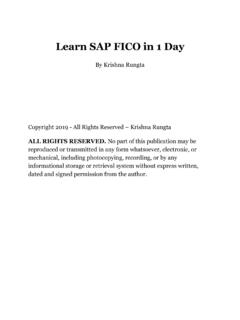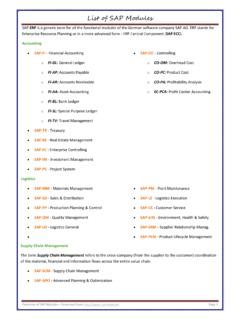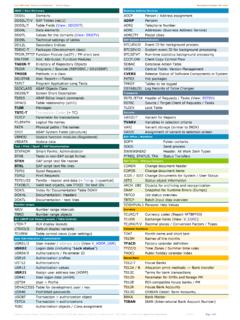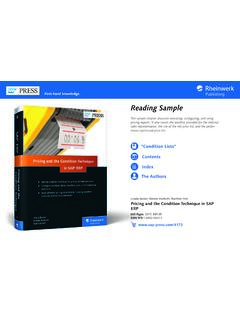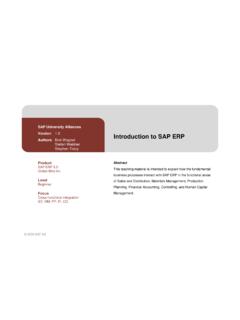Transcription of SAP Material Master For Beginners: Learn MM in 1 Day
1 SAP Material Master For Beginners: Learn MM in 1 Day By Krishna Rungta Copyright 2019 - All Rights Reserved Krishna Rungta ALL RIGHTS RESERVED. No part of this publication may be reproduced or transmitted in any form whatsoever, electronic, or mechanical, including photocopying, recording, or by any informational storage or retrieval system without express written, dated and signed permission from the author. Table Of Content Chapter 1: overview of SAP MM module Chapter 2: Introduction to Master Data in SAP Chapter 3: How to Create Material Master Data MM01 in SAP Chapter 4: How to Change Material Master Data (MM02, MM03) in SAP Chapter 5: How to Copy Material Master in SAP: MM01 Chapter 6: MM17: Mass Maintenance of Material Master in SAP Chapter 7: Material Master Views in SAP: The Ultimate Guide Chapter 8: Introduction to Purchasing & Purchase Requisition in SAP Chapter 9: ME11.
2 How to Create a Purchase Info Record in SAP Chapter 10: How to Change a Purchase Info Record: ME12 in SAP Chapter 11: How to Create a Purchase Requisition in SAP: ME51N Chapter 12: How to Convert Purchase Requistion to Purchase Order in SAP Chapter 13: ME41: How to Create RFQ (Request for Quotation) in SAP Chapter 14: ME47: How to Create Quotation in SAP MM Chapter 15: How to Compare Price for Different Quotation: SAP ME49 Chapter 16: How to Select or Reject a Quotation: SAP ME47 Chapter 17: How to Create a Source List Determination: SAP ME05 Chapter 18: How to Create a Purchase Order ME21N in SAP Chapter 19: How to Create Purchase Order with Reference ME58 | ME21N in SAP Chapter 20: ME22N: How to Change a Purchase Order in SAP Chapter 21: How to Post Goods Receipt: SAP MIGO Chapter 22: MIRO: How to Perform Invoice Verification in SAP Chapter 23: MRBR: Release Blocked Invoices in SAP Chapter 24: Service Purchase Order in SAP: ME23N Chapter 25: Outline Agreement in SAP.
3 Contract & Scheduling Agreement ME31 Chapter 26: Release Strategy, Procedure for Purchase Order in SAP: CT04, ME28, CL02 Chapter 27: overview Of Pricing Procedure in SAP Chapter 28: How to Define Access Sequence & Condition Table in SAP V/05, M/03 Chapter 29: How to Define Condition Types in SAP Chapter 30: How to Define Calculation Schema in SAP Chapter 31: How to Define Schema Group & Determination in SAP Chapter 32: SAP Inventory Management Tutorial: Movement Types {OMJJ} Chapter 33: How to Create Goods Receipt in SAP: MIGO, MB1C, MB03 Chapter 34: How to Reverse (Cancel) Goods Receipt MMBE in SAP Chapter 35: Reservation of Inventory in SAP MB21, MB1A, MBST, MB22 Chapter 36: How to Post Goods Issue in SAP MM VL02N, VL09 Chapter 37: Transfer Posting of Goods in SAP MB1B Chapter 38: SAP Physical Inventory Tutorial: MI01, MI02, MI04, MI07 Chapter 39: Special Stock & Special Procurement in SAP Chapter 1.
4 overview of SAP MM module Materials Management module in SAP consists of several components and sub-components. The most prominent and widely used are Master Data, Purchasing and Inventory. All of these components have their subcomponents that are essential in specific business processes, and all of the processes are executed by using transactions. Transaction (in SAP) means processing of certain information in order to complete business process requirement. For example, if you have purchased 10 pieces of litter buckets, you can perform particular transaction code (t-code) that will reflect those changes in SAP.
5 Most of the business processes involve multiple SAP transactions to be accomplished and are spread over one, two or more modules. Let s briefly talk about the various sub-modules in SAP MM Master Data Data stored in SAP R/3 is categorized as 1. Master Data and 2. Transactional Data. Master data is the core data that is used as a base for any transaction. If you are producing, transferring stock, selling, purchasing, doing a physical inventory, whatever your activity may be, it requires certain Master data to be maintained.
6 Example of Master Data Material Master data Customer Master data Vendor Master data Pricing/conditions Master data Warehouse management Master data (storage bin Master data) Learn more about Master Data here Purchasing Purchasing is a component of SAP MM module , and its process can be roughly depicted in below diagram. MRP ( Material resource planning) creates procurement proposal and later gets converted into Purchase Requisition. Next step is assigning a source to Purchase Requisition, and release of Purchase Requisition.
7 The PR gets converted to Purchase Order, and upon goods receipt, an invoice receipt can be done to complete the purchasing process. Additionally, payment is processed (in FI module ). Learn more about Purchasing here Inventory Management Inventory management is used to manage the inventory of the goods. It is based on several key processes like Definition of movement types Reservations Goods issue Goods receipt There are a number of functions and transactions used in the Inventory management processes. Learn more about Inventory Management here Pricing Procedure Pricing procedure in MM module is a way to determine prices in purchasing documents.
8 It gives us functionality to assign different calculation types for different needs. Defining a pricing procedure can be done by creating an access sequence, and assigning it to condition types. Access sequence tells the system where to look for the condition values. Learn more about Pricing Procedure here Chapter 2: Introduction to Master Data in SAP What is Master Data? Data stored in SAP R/3 is categorized as 1. Master Data and 2. Transactional Data. Master data is the core data that is used as a base for any transaction.
9 If you are producing, transferring stock, selling, purchasing, doing physical inventory, whatever your activity may be, it requires certain Master data to be maintained. Example of Master Data Material Master data Customer Master data Vendor Master data Pricing/conditions Master data Warehouse management Master data (storage bin Master data) The ones we will focus in MM module are Material Master and purchase info record. Material Master : What you should know about Material Master ? Material in SAP is a logical representation of certain goods or service that is an object of production, sales, purchasing, inventory management etc.
10 It can be a car, a car part, gasoline, transportation service or consulting service, for example. InInIn All the information for all materials on their potential use and characteristics in SAP are called Material Master . This is considered to be the most important Master data in SAP (there are also customer Master data, vendor Master data, conditions/pricing Master data etc), and all the processing of the materials are influenced by Material Master . That is why it's crucial to have a precise and well maintained Material Master .

